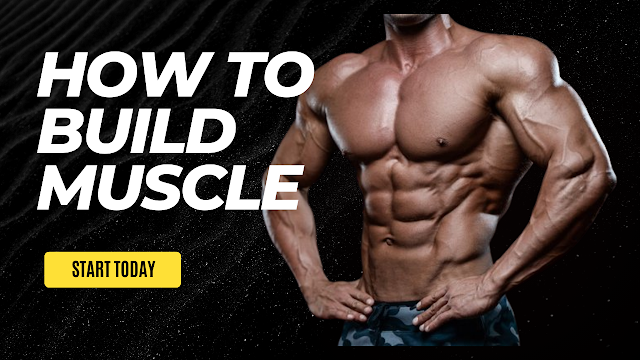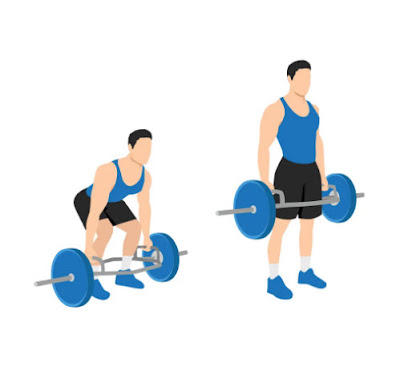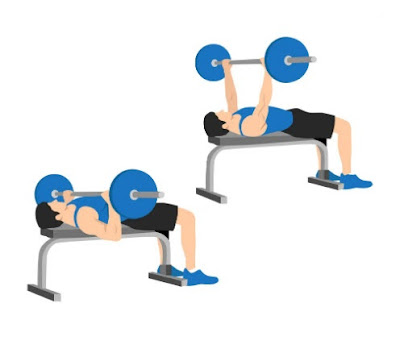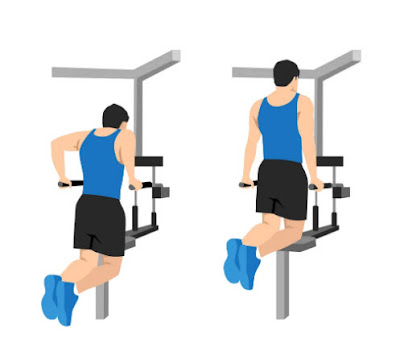Build Muscle is a goal shared by many individuals looking to improve their physical fitness and strength. Whether you are an athlete striving for peak performance, a fitness enthusiast aiming for a sculpted physique, or simply someone wanting to enhance their overall health, understanding the principles of muscle building is essential.
Why Build Muscle?
Let's face it, building muscle isn't just about looking good in a tank top (although that's definitely a perk). There are plenty of reasons why you should consider adding some
muscle to your frame.
For one, it helps improve your overall strength and functional fitness, making everyday tasks like lifting heavy grocery bags or carrying your neighbor's couch a breeze.
Plus, building muscle can also boost your metabolism, helping you burn more calories even at rest. So, if you want to be stronger, more functional, and burn more calories while binge-watching your favorite shows, building muscle is the way to go!
The Benefits of Building Muscle
Building muscle comes with a host of benefits that go beyond just looking swole.
Firstly, having more muscle mass can improve your body composition, helping you achieve a leaner and more toned physique. It also helps with injury prevention by strengthening your joints and improving your overall stability.
And let's not forget about the boost in confidence that comes with being stronger and more capable in your own body. So, whether you want to be the next Marvel superhero or simply feel more confident and capable in your everyday life, building muscle is a game-changer.
HOW TO BUILD MUSCLE MASS
When it comes to building muscle mass, here are Best 7 Muscle Building Exercises that are highly effective:
Squats are the king of all muscle and strength building exercises. No workout should be without deep squats. They are performed with a barbell, generally in a squat rack. Squats not only build massive legs, but also stress most of the upper body. They are like a hormonal nuclear bomb – destroying the entire body, forcing it to get bigger and stronger with every rep.
Deadlifts.
Second only to squats in effectiveness (and a very close second at that), deadlifts are another manmaker that will pack on slabs of muscle mass while helping you become as strong as a bear. Like squats, deadlifts are a barbell only exercise.
Bench Press.
The bench press is an upper body staple. There are several highly effective variations including the flat bench barbell press, flat bench dumbbell bench press, incline bench barbell press and incline dumbbell bench press.
Overhead Press.
As with the bench press, there are numerous quality variations of the overhead press that can be used. Nearly all seated and standing dumbbell and barbell overhead presses are solid choices. You may also use the Arnold dumbbell press, and behind the neck overhead presses. Another popular press variation is the standing push press.
Dips.
Dips are often called the upper body squat, and for good reason. Dips work the shoulders, chest and triceps very hard, and are a great overall exercises for building a beefy upper body. Dips should be performed at a parallel bar dipping station.
Pull Ups.
It seems that even the strongest and most fit lifters can barely squeak out more than a few pull ups. The pull up is an excellent exercise for building the back and biceps, and should be used instead of inferior exercises such as the lat pull down when possible.
Rows.
Both barbell and dumbbell rows are tremendous upper back exercises. Old school barbell T-bar rows are also a solid choice. While cable and machine lifts are generally sub-par, seated cable rows can be very challenging and effective.
These exercises are just a starting point, and there are many other effective exercises to consider.
Understanding the Science of Muscle Growth
Anatomy of Muscles
Don't worry, you don't need a degree in anatomy to understand how muscles work. At a basic level, muscles are made up of individual muscle fibers that contract and relax to create movement.
So, when you lift weights or perform any other type of resistance training, you're essentially creating tiny micro-tears in these muscle fibers.
It's during the recovery period that your body rebuilds and strengthens these fibers, leading to muscle growth and increased strength.
Mechanisms of Muscle Hypertrophy
Ah, muscle hypertrophy, the fancy term for muscle growth. It occurs when those little micro-tears we mentioned earlier are repaired and the muscle fibers become larger and stronger.
There are two primary mechanisms behind muscle hypertrophy: mechanical tension and metabolic stress.
Mechanical tension refers to the force placed on the muscles during resistance training, while metabolic stress is the buildup of metabolites (like lactic acid) that stimulates muscle growth.
So, basically, when you lift heavy stuff and feel the burn, that's your muscles getting bigger and stronger. Pretty cool, right?
Developing an Effective Workout Routine
Setting Clear Goals
Before you start pumping iron, it's important to set clear goals for your muscle-building journey.
Do you want to pack on serious mass? Increase your strength? Or maybe just achieve a more toned physique?
Having specific goals will help you tailor your workouts and track your progress more effectively.
Choosing the Right Exercises
When it comes to building muscle, not all exercises are created equal.
Compound exercises like squats, deadlifts, and bench press should be the bread and butter of your workout routine.
These exercises work multiple muscle groups simultaneously, allowing you to lift heavier weights and stimulate greater muscle growth.
So, skip the bicep curls for now and focus on those big, compound movements.
Designing a Progressive Overload Plan
If you want your muscles to grow, you need to constantly challenge them. That's where progressive overload comes into play.
It simply means gradually increasing the demands placed on your muscles over time.
This can be done by increasing the weight you lift, the number of reps and sets you perform, or even the intensity and complexity of your workouts.
By pushing your muscles beyond their comfort zone, you'll spark new growth and ensure you keep making gains.
Importance of Proper Nutrition for Muscle Building
Caloric Surplus and Muscle Gain
While hitting the weights is important, you can't ignore the role of nutrition in muscle building. To build muscle, you need to consume more calories than your body burns, creating a caloric surplus.
This provides your body with the energy and nutrients it needs to repair and build new muscle tissue. However, it's important to strike a balance and avoid going overboard with excessive calorie intake, as it can lead to unwanted fat gain.
So, fuel your gains with a moderate caloric surplus and pack in the nutrients your muscles crave.
Macronutrient Ratios for Optimal Muscle Growth
When it comes to macronutrients for muscle growth, protein takes center stage. It's the building block of muscle tissue and essential for repair and growth.
Aim to consume around 1 to 1.5 grams of protein per pound of bodyweight daily to ensure you're providing your muscles with adequate protein synthesis.
Additionally, don't forget about your carbs and fats. Carbohydrates provide the energy needed for intense workouts, while healthy fats play a role in hormone production and overall health.
So, balance your macros and give your muscles the nutrients they need to thrive.
Importance of Protein Intake
Protein, oh glorious protein, how we love you. As mentioned earlier, protein is crucial for muscle growth and repair.
It supplies the amino acids needed to rebuild and strengthen those muscle fibers after an intense workout. So, make sure to include lean sources of protein like chicken, fish, tofu, or legumes in your diet. And if you're struggling to meet your protein needs through food alone, protein powders can be a convenient and effective option to supplement your intake.
Embrace the power of protein and watch your muscles thank you.
Maximizing Strength and Endurance Training
Strength Training Techniques for Muscle Building
When it comes to building muscle, strength training is your best friend. But don't think you have to be a seasoned weightlifting pro to see results. Incorporating techniques like progressive overload, compound exercises, and proper form can go a long way in helping you build strength and muscle.
So, break out those dumbbells and get ready to pump some iron!
Incorporating Endurance Training for Balanced Development
While strength training is essential for muscle growth, don't forget about endurance training. Incorporating
cardio exercises like running, cycling, or swimming can help increase your stamina and overall fitness level. Plus, it adds variety to your workouts and keeps things interesting.
So, lace up those running shoes and get ready to break a sweat!
Recovery and Rest: Essential Elements for Muscle Growth
The Importance of Rest Days
Ah,
rest days – the unsung heroes of muscle building. It's during these glorious days of lounging and Netflix binge-watching that your muscles have a chance to repair and grow. Skipping rest days can lead to overtraining and increased risk of injury.
So, resist the temptation to hit the gym every day and embrace the power of rest. Your muscles will thank you.
Methods for Enhancing Recovery
But rest alone isn't enough. To enhance your recovery and optimize muscle growth, there are a few methods you can try. Incorporating stretching and foam rolling into your routine can help with muscle soreness and improve flexibility. Additionally, incorporating proper nutrition, hydration, and adequate sleep are crucial for recovery.
So, get your beauty sleep and eat your veggies – your muscles will thrive!
Supplementing for Muscle Building Success
Understanding the Role of Supplements
Supplements seem to be the shiny golden ticket to muscle building success, but let's not get too carried away. While some supplements can be beneficial, they are not magic potions. Understanding their role and finding the ones that work for you is key.
Remember, supplements should complement a solid diet and training routine, not replace them.
So, keep your expectations in check and focus on the basics first.
Key Supplements for Muscle Growth
If you're looking to dip your toes into the supplement world, there are a few that have shown promising results for muscle growth. Creatine, protein powder, and branched-chain amino acids (BCAAs) are popular choices among fitness enthusiasts. However, always consult with a healthcare professional or registered dietitian before adding any new supplements to your routine.
Remember, they're called supplements for a reason – they should supplement, not replace, a healthy lifestyle.
Overcoming Plateaus and Staying Motivated in Your Muscle Building Journey
Identifying and Breaking through Plateaus
Plateaus – the dreaded word in the world of muscle building. We've all been there, hitting that frustrating wall where progress seems to come to a screeching halt.
The key to overcoming plateaus is to mix things up. Try changing your exercises, rep ranges, or intensity levels.
Incorporating new techniques like drop sets or supersets can also help break through the stagnation. Remember, change is good – even when it comes to your workout routine.
Maintaining Motivation and Consistency
Building muscle takes time, effort, and a whole lot of consistency. It's easy to get discouraged or lose motivation along the way, but don't throw in the towel just yet.
Find ways to stay motivated, whether it's setting realistic goals, tracking your progress, or finding a workout buddy to keep you accountable.
And above all, remember to enjoy the journey. Celebrate your wins, no matter how small, and embrace the process. After all, Rome wasn't built in a day, and neither will your muscles.
In conclusion
Build Muscle requires dedication, consistency, and a solid understanding of the key principles involved. By following a well-designed workout routine, fueling your body with proper nutrition, prioritizing rest and recovery, and making smart use of supplements, you can maximize your muscle building potential. Remember, progress may not happen overnight, but with patience and perseverance, you will be rewarded with a stronger, more muscular physique.
So, lace up your training shoes, fuel your body with the right nutrients, and embrace the journey towards building the muscle you desire.
Frequently Asked Questions (FAQ)
1: How long does it take to build muscle?
The time it takes to build muscle varies for each individual and depends on several factors such as genetics, training intensity, nutrition, and consistency. Generally, noticeable muscle growth can be observed within a few weeks to a few months of consistent training and proper nutrition.
2: Can I build muscle without lifting heavy weights?
While lifting heavy weights is commonly associated with muscle building, it is not the only way to stimulate muscle growth. Resistance training using lighter weights, bodyweight exercises, or even resistance bands can also effectively promote muscle hypertrophy when performed with proper technique and progressive overload.
3: Do I need to consume protein supplements to build muscle?
While protein supplements can be a convenient way to meet your daily protein requirements, they are not essential for building muscle. A well-balanced diet that includes lean sources of protein such as chicken, fish, tofu, legumes, and dairy can provide adequate protein for muscle growth. However, protein supplements can be beneficial for individuals who struggle to meet their protein needs through whole foods alone.
4: How often should I work out to build muscle?
The frequency of your workouts will depend on various factors, including your training experience, recovery capacity, and individual goals. However, most individuals aim for strength training sessions 3-5 times per week, allowing for adequate rest days in between to facilitate muscle repair and growth. It is important to listen to your body, avoid overtraining, and prioritize recovery to optimize muscle building results.
These are Best Muscle Building Exercises.
What do you think of this guide?
Let me know by leaving a comment below, and don't forget to share this guide if you found it helpful.







